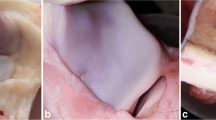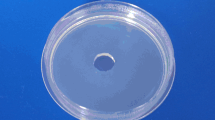Abstract
Implantation of tissue-engineered heterotopic cartilage into joint cartilage defects might be an alternative approach to improve articular cartilage repair. Hence, the aim of this study was to characterize and compare the quality of tissue-engineered cartilage produced with heterotopic (auricular, nasoseptal and articular) chondrocytes seeded on polyglycolic acid (PGA) scaffolds in vitro and in vivo using the nude mice xenograft model. PGA scaffolds were seeded with porcine articular, auricular and nasoseptal chondrocytes using a dynamic culturing procedure. Constructs were pre-cultured 3 weeks in vitro before being implanted subcutaneously in nude mice for 1, 6 or 12 weeks, non-seeded scaffolds were implanted as controls. Heterotopic neo-cartilage quality was assessed using vitality assays, macroscopical and histological scoring systems. Neo-cartilage formation could be observed in vitro in all PGA associated heterotopic chondrocytes cultures and extracellular cartilage matrix (ECM) deposition increased in vivo. The 6 weeks in vivo incubation time point leads to more consistent results for all cartilage species, since at 12 weeks in vivo construct size reductions were higher compared with 6 weeks except for auricular chondrocytes PGA cultures. Some regressive histological changes could be observed in all constructs seeded with all chondrocytes subspecies such as cell-free ECM areas. Particularly, but not exclusively in nasoseptal chondrocytes PGA cultures, ossificated ECM areas appeared. Elastic fibers could not be detected within any neo-cartilage. The neo-cartilage quality did not significantly differ between articular and non-articular chondrocytes constructs. Whether tissue-engineered heterotopic neo-cartilage undergoes sufficient transformation, when implanted into joint cartilage defects requires further investigation.





Similar content being viewed by others
References
Athanasiou KA, Niederauer GG, Agrawal CM, Landsman AS (1995) Applications of biodegradable lactides and glycolides in podiatry. Clin Podiatr Med Surg 12(3):475–495
Athanasiou KA, Agrawal CM, Barber FA, Burkhart SS (1998) Orthopaedic applications for PLA-PGA biodegradable polymers. Arthroscopy 14(7):726–737
Benya PD, Shaffer JD (1982) Dedifferentiated chondrocytes reexpress the differentiated collagen phenotype when cultured in agarose gels. Cell 30(1):215–224
Bradamante Z, Svajger A (1977) Pre-elastic (oxytalan) fibres in the developing elastic cartilage of the external ear of the rat. J Anat 123(Pt 3):735–743
Chung C, Burdick JA (2008) Engineering cartilage tissue. Adv Drug Deliv Rev 60(2):243–262
Chung C, Erickson IE, Mauck RL, Burdick JA (2008) Differential behavior of auricular and articular chondrocytes in hyaluronic acid hydrogels. Tissue Eng Part A 14(7):1121–1131
De Bari C, Dell’Accio F, Luyten FP (2001) Human periosteum-derived cells maintain phenotypic stability and chondrogenic potential throughout expansion regardless of donor age. Arthritis Rheum 44(1):85–95
Domm C, Schunke M, Christesen K, Kurz B (2002) Redifferentiation of dedifferentiated bovine articular chondrocytes in alginate culture under low oxygen tension. Osteoarthritis Cartilage 10(1):13–22
El Sayed KE, Haisch A, John T, Marzahn U, Lohan A, Muller RD, Kohl B, Ertel W, Stoelzel K, Schulze-Tanzil G (2010) Heterotopic autologous chondrocyte transplantation—a realistic approach to support articular cartilage repair? Tissue Eng Part B Rev 16(6):603–616
Endres M, Neumann K, Schroder SE, Vetterlein S, Morawietz L, Ringe J, Sittinger M, Kaps C (2007) Human polymer-based cartilage grafts for the regeneration of articular cartilage defects. Tissue Cell 39(5):293–301
Freed LE, Marquis JC, Nohria A, Emmanual J, Mikos AG, Langer R (1993) Neocartilage formation in vitro and in vivo using cells cultured on synthetic biodegradable polymers. J Biomed Mater Res 27(1):11–23
Gunatillake PA, Adhikari R (2003) Biodegradable synthetic polymers for tissue engineering. Eur Cell Mater 5:1–16 discussion 16
Hauselmann HJ, Aydelotte MB, Schumacher BL, Kuettner KE, Gitelis SH, Thonar EJ (1992) Synthesis and turnover of proteoglycans by human and bovine adult articular chondrocytes cultured in alginate beads. Matrix 12(2):116–129
Honda M, Yada T, Ueda M, Kimata K (2000) Cartilage formation by cultured chondrocytes in a new scaffold made of poly(l-lactide-epsilon-caprolactone) sponge. J Oral Maxillofac Surg 58(7):767–775
Isogai N, Kusuhara H, Ikada Y, Ohtani H, Jacquet R, Hillyer J, Lowder E, Landis WJ (2006) Comparison of different chondrocytes for use in tissue engineering of cartilage model structures. Tissue Eng Part A 12(4):691–703
Kafienah W, Jakob M, Demarteau O, Frazer A, Barker MD, Martin I, Hollander AP (2002) Three-dimensional tissue engineering of hyaline cartilage: comparison of adult nasal and articular chondrocytes. Tissue Eng Part A 8(5):817–826
Kergosien N, Sautier J, Forest N (1998) Gene and protein expression during differentiation and matrix mineralization in a chondrocyte cell culture system. Calcif Tissue Int 62(2):114–121
Kuhne M, John T, El-Sayed K, Marzahn U, Aue A, Kohl B, Stoelzel K, Ertel W, Blottner D, Haisch A, Schulze-Tanzil G (2010) Characterization of auricular chondrocytes and auricular/articular chondrocyte co-cultures in terms of an application in articular cartilage repair. Int J Mol Med 25(5):701–708
Kurz B, Lemke AK, Fay J, Pufe T, Grodzinsky AJ, Schunke M (2005) Pathomechanisms of cartilage destruction by mechanical injury. Ann Anat 187(5–6):473–485
Kusuhara H, Isogai N, Enjo M, Otani H, Ikada Y, Jacquet R, Lowder E, Landis WJ (2009) Tissue engineering a model for the human ear: assessment of size, shape, morphology, and gene expression following seeding of different chondrocytes. Wound Repair Regen 17(1):136–146
Loty S, Foll C, Forest N, Sautier JM (2000) Association of enhanced expression of gap junctions with in vitro chondrogenic differentiation of rat nasal septal cartilage-released cells following their dedifferentiation and redifferentiation. Arch Oral Biol 45(10):843–856
Malicev E, Kregar-Velikonja N, Barlic A, Alibegovic A, Drobnic M (2009) Comparison of articular and auricular cartilage as a cell source for the autologous chondrocyte implantation. J Orthop Res 27(7):943–948
Nakahara H, Bruder SP, Haynesworth SE, Holecek JJ, Baber MA, Goldberg VM, Caplan AI (1990) Bone and cartilage formation in diffusion chambers by subcultured cells derived from the periosteum. Bone 11(3):181–188
Naumann A, Dennis JE, Aigner J, Coticchia J, Arnold J, Berghaus A, Kastenbauer ER, Caplan AI (2004) Tissue engineering of autologous cartilage grafts in three-dimensional in vitro macroaggregate culture system. Tissue Eng Part A 10(11–12):1695–1706
Pelttari K, Steck E, Richter W (2008) The use of mesenchymal stem cells for chondrogenesis. Injury 39(Suppl 1):S58–S65
Pufe T, Petersen W, Fandrich F, Varoga D, Wruck CJ, Mentlein R, Helfenstein A, Hoseas D, Dressel S, Tillmann B, Ruhnke M (2008) Programmable cells of monocytic origin (PCMO): a source of peripheral blood stem cells that generate collagen type II-producing chondrocytes. J Orthop Res 26(3):304–313
Richter W (2009) Mesenchymal stem cells and cartilage in situ regeneration. J Intern Med 266(4):390–405
Schmal H, Mehlhorn AT, Kurze C, Zwingmann J, Niemeyer P, Finkenzeller G, Dauner M, Sudkamp NP, Kostler W (2008) In vitro study on the influence of fibrin in cartilage constructs based on PGA fleece materials. Orthopade 37(5):424–434
Schulz RM, Bader A (2007) Cartilage tissue engineering and bioreactor systems for the cultivation and stimulation of chondrocytes. Eur Biophys J 36(4–5):539–568
Schulze-Tanzil G (2009) Activation and dedifferentiation of chondrocytes: implications in cartilage injury and repair. Ann Anat 191(4):325–338
Schulze-Tanzil G, de Souza P, Villegas Castrejon H, John T, Merker HJ, Scheid A, Shakibaei M (2002) Redifferentiation of dedifferentiated human chondrocytes in high-density cultures. Cell Tissue Res 308(3):371–379
Schulze-Tanzil G, Mobasheri A, de Souza P, John T, Shakibaei M (2004) Loss of chondrogenic potential in dedifferentiated chondrocytes correlates with deficient Shc-Erk interaction and apoptosis. Osteoarthritis Cartilage 12(6):448–458
Schulze-Tanzil G, Muller RD, Kohl B, Schneider N, Ertel W, Ipaktchi K, Hunigen H, Gemeinhardt O, Stark R, John T (2009) Differing in vitro biology of equine, ovine, porcine and human articular chondrocytes derived from the knee joint: an immunomorphological study. Histochem Cell Biol 131(2):219–229
Stoll C, John T, Conrad C, Lohan A, Hondke S, Ertel W, Kaps C, Endres M, Sittinger M, Ringe J, Schulze-Tanzil G (2011) Healing parameters in a rabbit partial tendon defect following tenocyte/biomaterial implantation. Biomaterials (in press)
Xu JW, Zaporojan V, Peretti GM, Roses RE, Morse KB, Roy AK, Mesa JM, Randolph MA, Bonassar LJ, Yaremchuk MJ (2004) Injectable tissue-engineered cartilage with different chondrocyte sources. Plast Reconstr Surg 113(5):1361–1371
Yoo JU, Barthel TS, Nishimura K, Solchaga L, Caplan AI, Goldberg VM, Johnstone B (1998) The chondrogenic potential of human bone-marrow-derived mesenchymal progenitor cells. J Bone Joint Surg Am 80(12):1745–1757
Zhang L, Spector M (2009) Comparison of three types of chondrocytes in collagen scaffolds for cartilage tissue engineering. Biomed Mater 4(4):045012
Acknowledgments
We thank Dr. Katharina Stoelzel for her support. The authors also thank Ms. Hannah Gough for proof reading of the manuscript. This study was supported by grants from Bayer Innovation GmbH and the Sonnenfeld Foundation, Berlin.
Author information
Authors and Affiliations
Corresponding author
Additional information
A. Lohan and U. Marzahn contributed equally to the manuscript.
G. Schulze-Tanzil and T. John: joined senior authorship.
Rights and permissions
About this article
Cite this article
Lohan, A., Marzahn, U., El Sayed, K. et al. In vitro and in vivo neo-cartilage formation by heterotopic chondrocytes seeded on PGA scaffolds. Histochem Cell Biol 136, 57–69 (2011). https://doi.org/10.1007/s00418-011-0822-2
Accepted:
Published:
Issue Date:
DOI: https://doi.org/10.1007/s00418-011-0822-2




